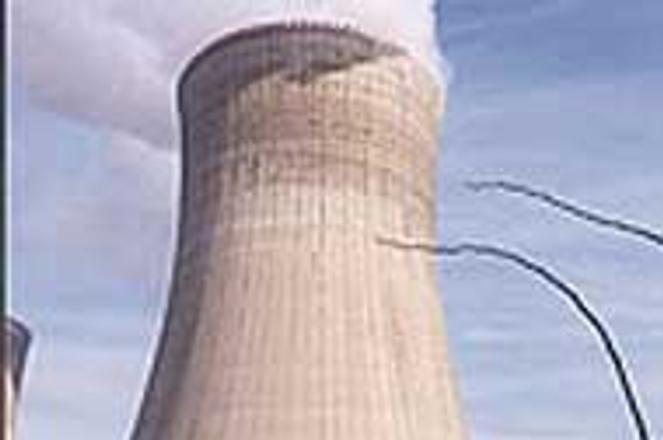One of the eight huge cooling towers at Mochovce nuclear plant.photo: Courtesy Mochovce
With their massive cooling towers rising over the horizon, nuclear power plants like Slovakia's Mochovce are the stuff 'millennium bug' doomsday scenarios are made of. But international and domestic observers say years of solid preparation by Slovakia's nuclear sector should prevent any systems failures as the clock strikes the year 2000.
The country's two nuclear facilities, in fact, appear to be in line with international norms for nuclear facility "Y2K" readiness. Work being done at Mochovce to update the computer systems began in 1997 and should be finished by June, plant managers said.
The millennium bug problem is one that affects computer chips that have outdated time components in them. Unable to recognize the '00' notation for the year 2000, computers and electronic devices containing these chips are widely expected to fail as the date changes to January 1, 2000, wreaking havoc on tranport, telecom and banking sectors.
Slovenské Elektrárne (SE), the operator of both of the country's nuclear power plants at Mochovce and Bohunice, has been under heavy scrutiny concerning its Y2K preparations. During a visit by The Slovak Spectator March 9, Mochovce plant managers said they understood the public's concern and added that every precaution had been taken.
"We certainly understand the desire of the country to be assured that every preparation will be completed and be completed properly," said Juraj Polačík, head of the Information Department at Mochovce and member of SE's Y2K preparation group. "Smaller companies may not have to worry so much about the Y2K, but we are obviously in a different situation."
While the general state of Y2K bug preparedness in Slovakia has been roundly criticised (see related article, this page) SE has been praised for its compliance with international standards and its willingness to grant inspections to western specialists.
David Lyscom, the British Ambassador to Slovakia and a self-styled specialist on Y2K preparations, said he believed that the nuclear power plants should be ready.
"A lot has been done on the nuclear side through the IAA [International Atomic Association]," Lyscom said. "I am pretty satisfied that they are doing a lot there."
"Our company is quite big and our equipment is of a higher risk," said Rastislav Petrech, the head of the Foreign Affairs and Public Relations Department for SE. "We simply could not leave it to chance that something might go wrong. Perhaps if we were a smaller, less significant company we could - but we are not in that situation. We are a very important company."
According to operators at Mochovce, which is located in a rural area of central Slovakia 120 kilometers from the Austrian border, preparations at the plant started over a year and a half ago.
"We first held discussions on the millenium bug in the fall of 1997," Mochovce's Petrech said. "By June, everything at the plant will be completely resistant to the Y2K bug and we will officially announce the completion of our readiness in our 'Declaration of Preparedness' on July 31, 1999."
Polačík said that numerous steps had been taken to confront the millennium bug problem and added that the public should rest assured that SE will have taken every step necessary to guarantee compliance to international safety standards.
"In the spring of 1998, we formed different teams assigned to different areas of concern," Polačík said. "The task of the teams was to map out the situation in extreme detail. The result of this was the creation of a list of equipment that could possibly be affected by the millennium bug."
Among the vulnerable equipment were the plant's banks of computers and control systems. Officials explained, though, that even in the worst-case scenario, the millenium bug could do no more than shut down the plant.
After determining the potential problems, Polačik explained, a financial plan was drawn up and contracts with suppliers who would aid in the preparations were begun. The physical preparations have now been under way for close to a year.
Although Petrech and Polačik maintained that nothing could go wrong, Lyscom told The Slovak Spectator that electricity grids, to which nuclear power plants are connected, are susceptible to "progressive collapse", whereby the failure of one system leads to the failure of another until the entire operation collapses.
"This kind of problem happened in New Zealand in a weather-related accident," Lyscom said. "There were just a few outages and then the whole system collapsed because of progressive failure. So that would be an area that would worry me."
"The automated systems [of nuclear power plants] are probably millennium vulnerable and by no means certain to fail-safe," he stated. "Millennium testing is crucial."
But SE officials insisted that precautions have been carried out and that Mochovce is "progressive collapse-proof." Róbert Holý, Mochovce Information Centre Manager, explained that the plant has two control centres, in case any unforeseen problems should arise.
"The first control centre has complete Y2K preparedness," Holý said. "However, if anything should go wrong at all, we have a second control centre. This centre is run by generator, so the millennium bug could not affect it. The only operation the second control centre is capable of is a complete and safe shut-down of the plant."
Holý added that the plant's second control centre was not built in response to potential problems resulting from the Y2K bug. "This is a standard international safety feature," Holý said. "Besides the fact that we have a different plant design here, this safety measure adds assurance that Mochovce is not a potential Chernobyl waiting to happen."


